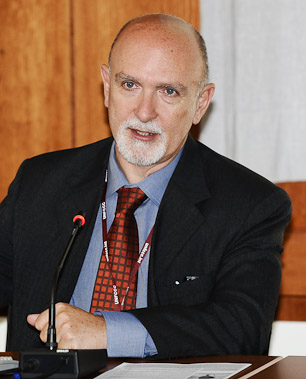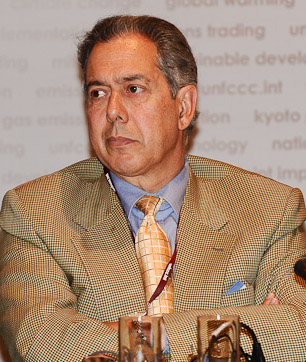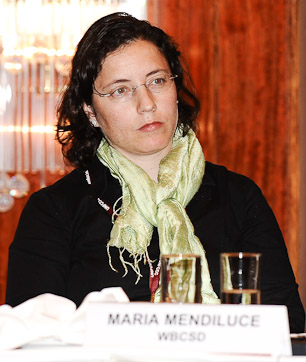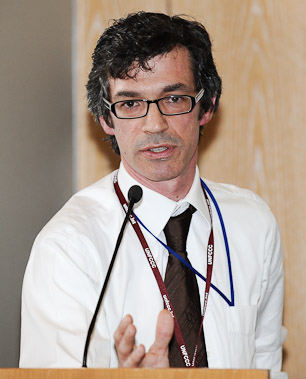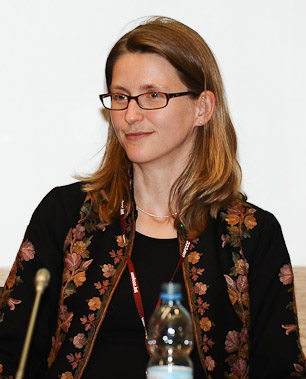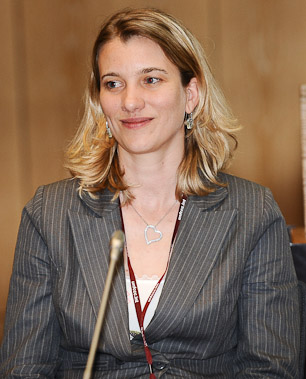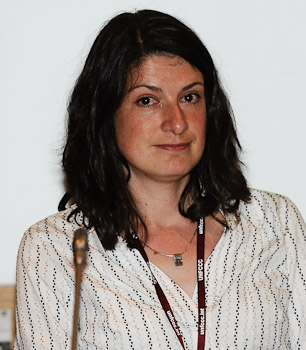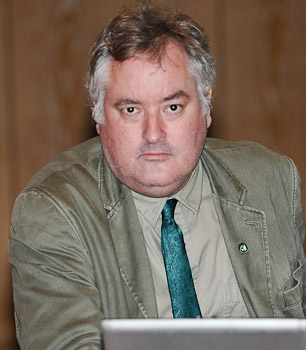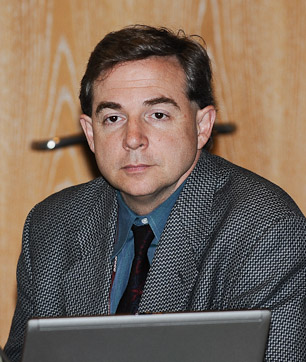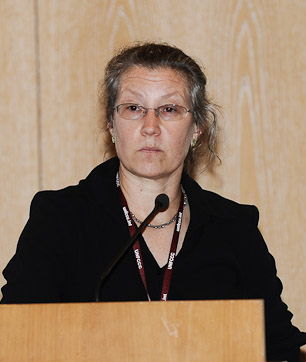 |
A Special Report on Selected Side Events at the 1-12 June 2009 Bonn, Germany |
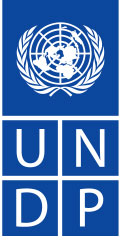 |
| Daily Web Coverage and Reports | ||||||||||||||||||||||||
| 1 June | 2 June | 3 June | 4 June | 5 June | 6 June | 8 June | 9 June | 10 June | 11 June | 12 June | ||||||||||||||
| HTML | ||||||||||||||||||||||||
Events on Thursday, 11 June 2009
Risk Reduction, Poverty Alleviation and Insurance in a Changing Climate
Presented by the UN International Strategy for Disaster Reduction (UN/ISDR)
This event highlighted key findings of two UN/ISDR reports on risk reduction, adaptation and insurance within the context of climate change.
Andrew Maskrey, UN/ISDR, presented key outcomes of a collaborative report entitled “Risk and Poverty in a Changing Climate.” He highlighted global-level findings, including that: disaster risk is concentrated in a small part of the world, particularly in highly populated developing countries that are prone to natural hazards; in relative terms, small countries with small economies are most at risk; risk is increasing; and risk, measured in terms of mortality and economic loss, can be over 100 times greater in countries with lower incomes and human development levels.
At the local level, Maskrey said: low-intensity damage and asset loss is widespread but largely overlooked; weather-related extensive risk is rapidly increasing; and disaster impacts are associated with both short- and long-term poverty outcomes, including decreased school enrollment and nutrition deficiencies.
Maskrey said the report identifies three drivers of risk that are all exacerbated by climate change: deficient urban and local governance; vulnerable rural livelihoods; and declining ecosystem services. He noted that while disaster preparedness and response are reducing mortality, progress in tackling the drivers of risk is insufficient.
Christoph Bals, Germanwatch, presented results of a collaborative report entitled “Adaptation to Climate Change: Linking Disaster Risk Reduction and Insurance.” He listed challenges to effectively implementing insurance mechanisms, including: low awareness levels; lack of reliable information on risk pricing; accessibility; affordability; and the potential for insurance to incentivize mal-adaptation. He said direct investment, such as restoring mangroves, can be cheaper than insurance payouts, and highlighted the potential of making risk reduction a pre-requisite to accessing insurance. He stressed that insurance can play a positive role if embedded in the right risk reduction environment, which in turn must be embedded in the right adaptation environment.
Participants discussed, inter alia: the urgency of addressing risk; the importance of addressing development, adaptation, risk and development holistically; the possibility to insure ecosystem goods and services given that poor populations often depend on these for their livelihoods; the importance of referencing the Hyogo Framework of Action in the text of a post-2012 climate regime in order to address technical and political aspects of risk; and the need for communities and local and national governments to work together to address risk.
|
|
Climate Change and Intellectual Property: Challenges and Options on the Road to Copenhagen and Beyond
Presented by the UNFCCC Secretariat
This event considered intellectual property rights (IPRs) and technology transfer (TT). Several panelists stressed the importance of: defining intellectual property; distinguishing between types of TT; and relying on the business sector for TT.
Wanna Tanunchaiwatana, UNFCCC Secretariat, stressed the need to balance IPRs and policy needs. She presented statistics on technology needs assessments, and said negotiations are considering various policy options, including compulsory licensing for patented technologies and exempting LDCs from patent protection.
Carloz Mazal, World Intellectual Property Organization, said IPRs can be used to facilitate technology transfer, and stressed the importance of an enabling environment and a stable investment climate.
Antony Taubman, World Trade Organization (WTO), stated that, inter alia: technology practices depend on individual choices by patent holders; and the climate debate on TT involves ethical and human rights dimensions as well as national self-interest in technology diffusion.
Rae Kwon Chung, the Republic of Korea, noted that governments routinely override IPRs in matters of national defense, and suggested considering whether climate change constitutes a national security issue that justifies government intervention.
Maria Mendiluce, World Business Council for Sustainable Development, said that IPRs are not a barrier to TT and do not block innovation, nor do they favor developed countries or create monopoly power or induce higher prices.
Zou Ji, Renmin University, China, stressed the importance of political commitment to cooperate on TT, and suggested creating an international subsidiary body on technology transfer and establishing an international fund.
Kazuhiko Hombu, Japan, said it is impossible to solve legal issues around TT, noting that a single product involves hundreds of IPRs. He stressed the importance of facilitating TT through joint ventures, and cautioned against new global bureaucratic structures.
|
|
Electricity and Climate Change
Presented by the International Energy Agency (IEA)
Richard Baron, IEA, opened the session, noting that electricity is the fastest growing sector in terms of emissions.
Paul Waide, IEA, discussed energy efficiency in consumer electronics. He said electricity demand for electronics is likely to: grow 250% by 2030; become equivalent to the current residential consumption of the US and Japan combined; and entail US$200 billion in electricity bills. Adding that 50% energy savings by 2030 can be achieved at low cost using currently available technologies, while best-available technologies can save US$130 billion in energy bills by 2030, Waide stressed that these savings will not occur without strong government policy interventions.
Richard Baron, IEA, discussed sectoral approaches. He stated, inter alia, that: the possibility of sectoral crediting mechanisms creates major uncertainty about the supply-demand outlook; intensity-based crediting is a data-intensive policy instrument that requires reliable projections of future trends; and appropriate domestic policy tools can be determined only on a case-by-case basis.
Tom Kerr, IEA, reported on IEA work on developing “energy technology roadmaps.” He stated that carbon capture and storage (CCS) is a key low-cost policy option that can provide a large amount of CO2 reductions by 2050. Kerr noted: multibillion dollar CCS investments in Canada, Australia, the US and the EU; insufficient investments in CCS in the cement, chemicals, and iron and steel sectors; and the need to identify metrics and financing options for CCS.
Participants discussed, inter alia: the need to develop roadmaps for energy efficiency; information needs for future roadmap development; the multiple policy-making fora related to electricity; the importance of local conditions and country-specific baselines; and the importance of raising awareness on energy waste.
|
|
Parallel Worlds – The Role of Observer Organizations in the COP Process
Presented by the Environmental Change Institute (ECI), University of Oxford
This event discussed the increasingly prominent role that observer organizations play at climate summits.
Heike Schroeder, University of Oxford, UK, discussed the role of global cities in international climate change negotiations. She concluded that some cities have taken a leadership role but are not autonomous actors, explaining that cities depend on direction provided by national and international actors.
Elke Schüßler, Freie University Berlin, Germany, and Bettina Wittneben, University of Oxford, described COPs as “Field-Configuring Events” (FCEs). They defined FCEs as temporary organizational settings that represent and shape the development of technologies, industries, professions and markets. They concluded that it is difficult to classify the COP as a single FCE because, inter alia, actors experience the COP differently due to inherent constraints.
Björn-Ola Linnér, Linköping University, Sweden, reported on a study entitled “The Role of Side Events: Results from a Survey at COP 13 and 14.” He highlighted six functions of side events, including: building capacity; introducing potential items for negotiations; and legitimizing global governance.
John Drexhage, International Institute for Sustainable Development, Canada, and Barbara Black, World Business Council for Sustainable Development, responded to the presentations. Drexhage highlighted that side events are catalysts for developing policy and noted the role that ENBOTS plays in “promoting the profile” of these events. Black said side events promote ideas that may not influence concurrent negotiations but that initiate discussions that can be important later in the negotiating process.
Participants discussed, inter alia: whether side events influence the negotiations; and the role of youth organizations.
|
|
Potential GHG Impacts of Future LULUCF Activities in Developed Countries Under the Second Commitment
Presented by the United Kingdom (UK)
This panel discussed potential GHG impacts of future Land Use, Land-Use Change and Forestry (LULUCF) activities in developed countries under a second commitment period of the Kyoto Protocol.
Jim Penman, UK, opened the event, stressing the importance of numbers in helping governments to make decisions, noting that the panelists would be presenting aggregated rather than country-specific results. John Watterson, AEA Technology, UK, explained that while the accounting rules may still be under negotiation, the underlying mitigation potentials will not change.
Robert Matthews, Forest Research, UK, introduced the CARBINE model, which he used to predict how changes in forest management may affect emission reductions in this sector. He explained, inter alia, that options aimed at achieving a balance of impacts across the LULUCF, energy and materials sectors can achieve greater emission reductions compared to actions aimed at enhancing only LULUCF by 2030.
Philippa Lincoln, University of Aberdeen, UK, discussed the technical and economic mitigation potential for cropland and grassland management. She explained that the contribution of grassland management to realizable mitigation potential through sequestration increases as carbon prices increase, while that of cropland management decreases because of shifts to afforestation or bioenergy at the highest prices in some regions.
Participants discussed various aspects of the model, including: whether it would be possible to overlay mitigation potential with biodiversity aspects to explore issues such as the impacts of forest management on biodiversity; the mitigation potential of taking soils out of production; whether the model incorporates economic linkages and leakage issues that may result from taking forests out of production in developed countries; whether the model accounted for transitions between grassland and cropland; and the possibility to conduct a sensitivity analysis for different reference cases.
|
|
Climate Change and Agriculture: Reducing Annex I’s Foodprint?
Presented by the Institute for Agriculture and Trade Policy (IATP)
This event examined the role of agriculture in both contributing to and mitigating climate change, particularly in Annex I countries.
Doreen Stabinsky, Greenpeace International, highlighted that 17-32% of all human-induced GHGs are emitted directly or indirectly by the agriculture sector. Noting that nitrous oxides and methane are the main GHGs emitted by the agriculture sector, she added that agriculture contributes 60% of emissions from those sectors that emit non-CO2 gases. She said 89% of agriculture’s climate change mitigation potential comes from soil carbon sequestration, but that reductions in methane and nitrous oxides can also have significant impacts.
On soil carbon sequestration, Stabinsky noted additional benefits, including improved nutrient cycling, soil fertility and water conservation. She said soil carbon sequestration can be enhanced by, inter alia: avoiding leaving land bare; coupling reduced tillage and organic production methods; reducing grazing intensity; and shifting land use from annual to perennial crops. On fertilizer use, Stabinsky noted that an average of 50% of nitrogen used in farming is lost to the environment. She suggested better integrating animal and crop production to take advantage of fertilizers from animal manures.
Jim Harkness, IATP, US, stressed the multifunctionality of agriculture, noting it is linked to water, climate, social systems and the economy. He said previous attempts to increase agricultural productivity focused too narrowly on technological and economic solutions. Harkness argued that these were the real drivers of the 2008 food crisis, and that oil prices, biofuels and speculation were simply the triggers.
Harkness expressed concern that the mistakes of the past could be repeated if agriculture’s multifunctionality is overlooked as agricultural carbon sequestration potential gains attention. Noting increased discussion on offsets in the US, he encouraged caution, noting that non-equivalence and non-permanence are problems in the agriculture sector. He recommended capping emissions in the agriculture sector and setting performance standards. Harkness emphasized the need to rebalance diets in the west, highlighting that one billion people are obese and that this trend is growing.
Lim Li Lin, Third World Network, stressed the importance of addressing climate change in a way that is mutually beneficial for agriculture and for the climate. She highlighted research demonstrating that current agricultural policies and practices encourage energy-intensive farming and marginalize small farmers, and encouraged research and development that taps traditional knowledge as well as modern scientific approaches.
Lin described the ways in which agriculture has been incorporated into the Ad Hoc Working Group on Long-term Cooperative Action’s draft negotiating text, including references to: mitigation technologies; means of implementation for adaptation; and measures to address intellectual property rights.
Participants discussed: the impacts of measures such as eco-labeling and subsidies on developing countries; the potential for reduced tillage to increase labor requirements and herbicide use; payment for environmental services in the agriculture sector; and the need to recognize that different soil types and ecosystems require different management approaches.
 |
| L-R: Doreen Sabinsky, Greenpeace International; Lim Li Lin, Third World Network; Rachel Berger, Practical Action; and Jim Harkness, IATP |
|
|
| Daily Web Coverage and Reports | ||||||||||||||||||||||||
| 1 June | 2 June | 3 June | 4 June | 5 June | 6 June | 8 June | 9 June | 10 June | 11 June | 12 June | ||||||||||||||
| HTML | ||||||||||||||||||||||||
Digimarc and the Digimarc logo are registered trademarks of Digimarc Corporation. The "Digimarc Digital Watermarking" Web Button is a trademark of Digimarc Corporation, used with permission.
Please e-mail the Digital Editor should you have any questions regarding the content of this page.
| Back to IISD RS "Linkages" home | Visit IISDnet | Send e-mail to ENB |
© 2009, IISD. All rights reserved.


